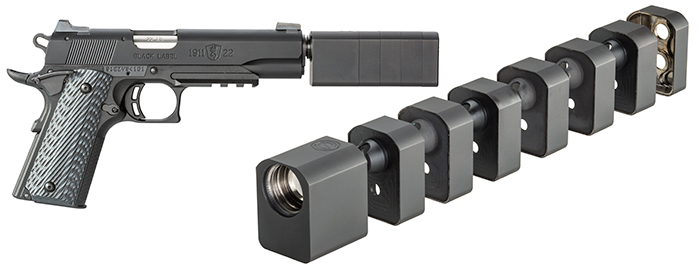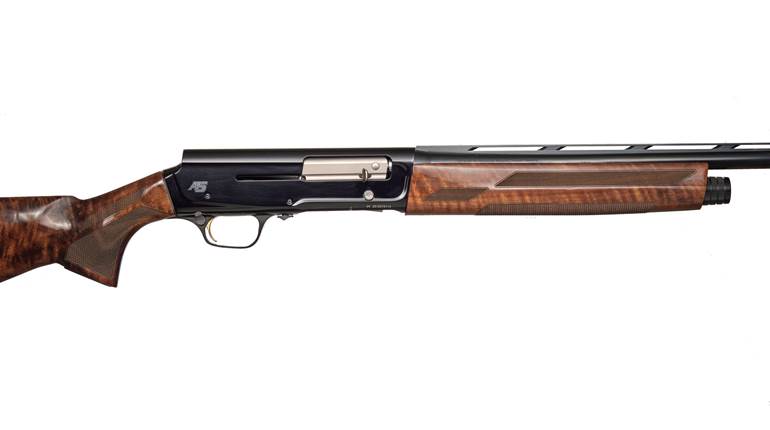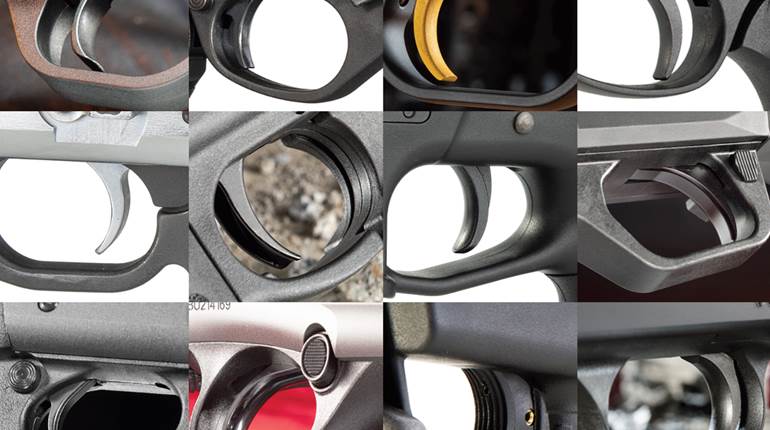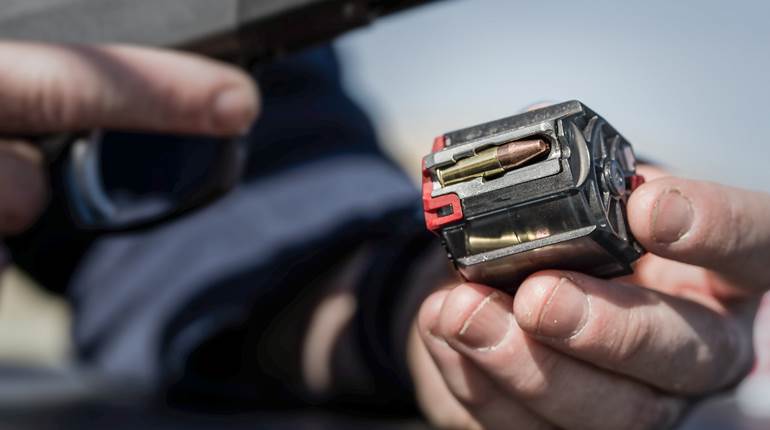
(Image above is a SilencerCo Osprey Micro sound suppressor on a Browning Black Label 1911-22 pistol, and a box of the new Browning .22 LR ammo.)
In Norway a person can walk into a gun store and buy a firearm silencer without filling out paperwork and leave with it minutes later. And why not? After all, silencers, perhaps more accurately described as sound suppressors, reduce noise and prevent damage to shooters’ ears, mitigate recoil, can increase accuracy and generally make shooting more pleasurable for all concerned. But thanks to the ruthless actions of outlaw Al Capone more than 80 years ago—and the anti-gun politics of today—law-abiding Americans face unreasonable scrutiny when buying a simple firearm accessory that should be as commonplace as ear muffs. Thanks to the efforts of NRA’s Institute for Legislative Action, 41 states now allow ownership, with more expected to follow. True, it’s a red-tape-laden process to purchase a silencer, and it’s not inexpensive, but you should consider owning and using suppressors anyway. Here are a few reasons why, along with the story of how silencers came into being—and then became so misunderstood.
Five Reasons To Own A Silencer
Greater Safety: According to the National Institute on Deafness and Other Communication Disorders, “15 percent of Americans between the ages of 20 and 69 (26 million people) have high-frequency hearing loss due to exposure to noise at work or during leisure activities.” This includes tinnitus, or acute ringing in the ears, and if you don’t think gun owners are at risk, then just attend an NRA Annual Meeting—hearing aids abound.
The Occupational Safety and Health Administration (OSHA) has determined that the threshold for noises that are safe to the human ear is 140 decibels (dB).* For reference, a typical .308 Win. bolt-action rifle emits an average of roughly 158 dB per shot; a cap gun is roughly 155 dB, a balloon pop 125 dB, fireworks 162 dB; normal conversation averages 65 dB. Silencers decrease the decibel level of a supersonic firearm by 14 to 45 dB, depending on the silencer, the load and the firearm to which it’s attached. On average, a commercially made silencer reduces that .308’s decibel level by 30 dB, producing a decibel level of 128—a figure that’s well under OSHA’s 140 dB threshold.

Happier Neighbors: One of the largest challenges facing gun owners today is noise complaints stemming from normal activities at suburban gun clubs. As suburbia continues to sprawl, many times prospective homeowners are forewarned of the trap and skeet field a few blocks away, but the price is right and so they buy. Yet a few months later they complain about the noise and file a petition to shut down the range. Sometimes they win. Most of these people aren’t necessarily anti-gun, they just don’t like the noise. That’s why NRA’s gun range pre-emption legislation is so important. But it wouldn’t be necessary if guns were less noisy. Firearms equipped with silencers make for happier neighbors. And happy neighbors harbor more good will toward guns and gun owners.

Ethical Hunting: As the country grows more urban, hunters are finding themselves chasing game closer to human habitation. Any time guns are discharged near the non-hunting public, the chance of confrontation is exacerbated. Silencers mitigate that chance.
Thanks to the efforts of NRA-ILA, silencers are legal for hunting in 37 states now, and not just for big game. A couple of companies, including SilencerCo and Xcaliber Firearms, make suppressors for shotguns. If my duck hunting buddies and I had had such tools years ago, we’d still be able to tell our hunting stories to each other in normal voices. Silencers spook game less and make for more accurate, and therefore more humane, hunting.
Effective Defense: If you get into a gunfight while defending your home, you may survive, but your ears will likely sustain permanent damage. Sound waves rebound in the close confines of homes, sending them directly back and onto your eardrum. Even one shot in a home or car could mean permanent hearing loss. So, why not outfit your favorite home-defense firearm with a silencer? If you don’t like the added length, begin with a shorter barrel.

Enhanced Accuracy: Most people shoot a .223 Rem. better than a .338 Win. Mag. Why? Despite what we want to believe, few of us are actually immune to recoil, so we tend to shoot better with light-recoiling guns. Much like a muzzle brake, silencers reduce recoil by countering the gas pressure that would otherwise force the gun straight back into a shooter’s face and shoulder. They also reduce perceived noise. Quiet guns are easier to shoot. Try it.
Most silencers, while they may slightly alter the point of impact, do not necessarily make the firearm less accurate. To the contrary, oftentimes they cause the firearm’s groups to shrink.

The Short Story Of The Silencer
Hiram Percy Maxim was born to Hiram Stevens Maxim, the inventor of the Maxim machine gun. In 1901, the young Maxim developed two inventions parallel with each other because they were basically the same product in concept and design. His Maxim Silencer Company produced both the automobile muffler and the firearm silencer in 1902. The silencer was basically a metal tube containing a series of curved baffles that allowed gas from the cartridge to be released more gradually to form sound waves with less dramatic peaks. It was patented in 1909. Iterations of his car muffler went on to become standard factory equipment for every street-legal automobile sold—and were even government-mandated—while his firearm silencer became unreasonably regulated in 1934 with the National Firearms Act (NFA).
In fighting the wave of organized crime at that time, lawmakers thought it prudent to restrict certain types of arms and accessories. While neither explanation nor criminal evidence were offered during the 1934 Congressional hearings regarding why silencers were targeted by that year’s eminent NFA, it’s speculated that Congress wished to regulate any firearm or firearm accessory to which law enforcement of the day did not routinely have access. Black and white images of Al Capone’s Tommy Gun and the St. Valentine’s Day Massacre were fresh in citizens’ minds, and so they did not protest. In doing so, silencers for firearms were all but regulated out of the consumer marketplace. Maxim eventually pivoted his silencing technology to other markets, and today his name and expertise lives on via Maxim Silencers, Inc., a Texas-based multi-million-dollar manufacturer of silencers and mufflers for turbines, engines and industrial equipment.

In 1934, just as now, law-abiding Americans could legally buy a silencer after they passed a background check, registered the serialized silencer along with their fingerprints and paid a $200 “transfer fee”—popularly called a “tax stamp,” because it’s issued as a stamp, and it’s tantamount to an excise or “sin” tax. The stamp legalizes one particular silencer so that it can be used on any legal firearm. Very few silencers were registered or sold in those days, but that’s not surprising considering that in 1934, amid the Great Depression, average Americans couldn’t justify a $3.50 gadget for their firearm, much less a $200 tax. Furthermore, society at large didn’t understand high-decibel hearing loss and certainly didn’t attribute it to guns. But even if it did, the $200 tax stamp—or $3,500 in 2015 dollars—effectively placed a silencer out of reach for most except the mafiosos whom the government credits as necessitating the restrictions in the first place. For the next 75 years, only a few small companies made silencers for commercial sale, and pretty soon most Americans assumed they were illegal. The only time anyone saw a silencer in use was in a Hollywood hitman flick, wherein a black-cloaked villain would snuff his mark with a whisper from his Walther before walking from the crime scene undetected.
Silencers, Crime And The Law
The 1968 Gun Control Act didn’t do anything to help gun-owning Americans who cherish their hearing; instead it only solidified silencers’ place among those “scary” devices subject to regulation and scrutiny.
Miles Edward Haynes was already a convicted felon when he was charged with failing to register an NFA-type firearm under the 1934 National Firearms Act. In 1968, the Supreme Court, in a 7-1 decision, sided with his argument that registering the firearm (which was already illegal for him to own) self-incriminated him, and so the ruling made the registering portion of the act unenforceable. So, in 1968, Title II was added to the Gun Control Act, that, among other things, mandated that the acquisition of a silencer be federally registered and pre-approved by the attorney general. It maintained the $200 transfer tax. There were no sound arguments given in testimony—indeed little mention of silencers at all—regarding why they should be scrutinized. According to Paul A. Clark in his “Criminal Use of Firearms Silencers” paper in the Western Criminology Review, “one Congressman [who testified] thought silencers were used to convert weapons into machine guns.”

Yet in 1986, Congress passed a law mandating a 20-year enhanced sentence for committing a crime with a silencer, and, in 1988, it was increased to a mandatory 30 years. As Clark notes, this is one of the harshest criminal penalties in the American legal system—in many cases more severe than murder.
According to the National Shooting Sports Foundation, between 1995 and 2005 there were “153 federal criminal cases involving suppressors, only 15 of which involved the actual use of the suppressor in the commission of a crime. Less than 0.1 percent of homicides in federal court, an infinitesimally low 0.00006 percent of felonies in California and a mere 0.1 percent of armed robberies involve a suppressor.” During the same time frame, there were two documented murders in which a suppressor was used.
In sum, silencers are very rarely used in crime, and there’s no evidence that indicates they would be used more frequently if their regulations were removed. As of July 2015, 41 states allow silencers, with Vermont and Minnesota being the latest to legalize their use.
While anti-gunners believe there is no sporting use for silencers, facts conclude otherwise. To the contrary, I think big government’s anti-noise-pollution initiatives and green incentives should pay us for using silencers. In the last 15 years or so, that $200 dollar tax stamp is more akin to a couple cell phone bills rather than a monthly salary, so more shooters are splurging. While the $200 fee is ridiculous and should be zero, BATFE transfer data reveals that gun enthusiasts are beginning to buy silencers more frequently now that they’re becoming aware of their vast benefits. According to American Suppressor Ass’n (ASA), “The BATFE estimates that the number of firearms noise suppressors owned by Americans has doubled since 2011 to nearly 572,000 in 2014.”
“Educational initiatives, the passage of pro-suppressor legislation and increasingly innovative products have all contributed to the proliferation of suppressors,” said Knox Williams, ASA president and executive director.
Private manufacturers are noticing. In the past five years, a dozen or more manufacturers have opened doors, and, as a result, silencer technology is rapidly advancing. Modern machining techniques using newer materials such as aluminum, titanium, Stellite (that’s harder and more durable than titanium) and Inconel (an austenite nickel-chromium superalloy) are being developed. Meanwhile, established gun companies such as SIG Sauer and BPI Outdoors (the makers of CVA muzzleloaders and now Dead Air suppressors) are storming the market with their manufacturing might.

Final Thoughts
Every shooter and hunter should consider using suppressors. The fact is, silencers offer myriad benefits to shooters and only one disadvantage aside from their additional cost—they alter the balance and length of most guns, making them somewhat less handy to carry. Regardless, silencers should be mainstream and as easy to buy as a standard firearm or even ammunition. For all of the previously stated reasons, you should consider purchasing a silencer. Your doing so will create more competition and likely cause prices to come down. It will also make silencers more mainstream. Until average gun owners and the general public see silencers being used by everyday Americans in deer stands and public gun ranges, their perception of this wonderful firearm accessory will remain in the hands of Hollywood. Countries such as Finland, Poland, Norway and Sweden, to name a few, have long recognized the advantage of firearm suppressors and advocate their use.
It’s about time America does, too.
Read "How To Buy a Silencer" to learn the U.S. process.
*Decibel levels and sound waves are very tough to measure. Common sound-measuring devices measure the peak sound wave and not the sustained noise that makes the sound more painful and more damaging to hearing. Consider that a .300 Win. Mag. and a .30-’06 Sprg. produce the same decibel reading, but the .300 Win. Mag. is noticeably louder to most shooters.
Silencer Manufacturers
Advanced Armament Corp. advanced-armament.com
AWC awcsilencers.com
Bowers Group LLC subguns.org
Coastal Gun Inc. coastalgun.com
Dead Air Armament deadairsilencers.com
Degroat Tactical armamentsales.com
Gemtech gem-tech.com
Griffin Armament www.griffinarmament.com
Black Rain Ordnance blackrainordnance.com
Huntertown Arms huntertownarms.com
Innovative Arms innovativearms.com
Dark Horse Arms fullysuppressed.com
Knight’s Armament knightarmco.com
Liberty Suppressors libertycans.net
Mack Brothers macbros.com
Suppressed Armament Systems suppressedarmament.com
Shark Suppressors sharksuppressors.com
SIG Sauer sigsilencers.com
SilencerCo silencerco.com
SRT Arms srtarms.com
SureFire surefire.com
Tactical Innovations Inc. tacticalinc.com
Tactical Solutions tacticalsol.com
TBA Suppressors tbasuppressors.com
Templar Tactical Firearms templartacticalfirearms.com
Thompson Machine Sound Suppressors thompsonmachine.net
Thunder Beast Arms Corp. thunderbeastarms.com
Trident Arms tridentarms.us
TROS trosusa.com
X-Caliber Firearms xcaliberfirearms.com
Yankee Hill Machine yhm.net

Notes On Accuracy
While the majority of rifle and “can” combinations I fired became slightly more accurate (on average by 0.2" at 100 yds.) than the same unsilenced gun, no two particular loads, barrels and silencer setups perform exactly the same. This is due to barrel harmonics. A silencer adds weight to the end of the barrel, which in turn affects its harmonic signature when a bullet exits it. Generally speaking, the heavier the barrel and lighter the silencer, the less shift in point of impact you’ll experience after installing it. (This is one advantage of lighter titanium models.) In plenty of cases a suppressor helps accuracy, but in some it may negatively affect it.
If you are unhappy with your silencer’s performance on your particular firearm, try adding weight to it with lead tape or by experimenting with various loads, bullets and combinations thereof. Or you can attach the silencer on another rifle and test it. Each rifle tends to be an individual, and adding a silencer merely adds another variable into the accuracy equation.
Frank Orman, a licensed silencer dealer in Oklahoma, and his daughter Kalie shoot and test cans extensively for business, training and recreation. “The majority of shifts (from non-suppressed zero) I witness are low right, usually within one minute of angle,” said Orman. “On handguns, I haven’t had one shift the impact enough to worry about. On long-range rifles, however, mirage from the intense heat of the silencer can be an issue, but it’s controllable. Just let it cool.”
Generally speaking, silencers that are installed via direct thread to the barrel tend to be slightly more accurate than quick-detach models that have bulky adaptors.
During chronograph testing, some silencers added 15 to 25 f.p.s. to a bullet’s velocity thanks to the slight pressure increase they create. But most of my data suggests that there is negligible velocity disparity between suppressed and unsuppressed firearms with modern, quality-made cans.
What is certain is that zeroing and shooting is made much more pleasurable when using a silencer.






































